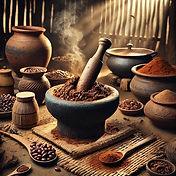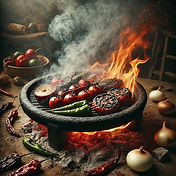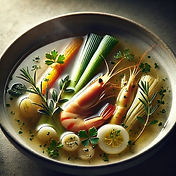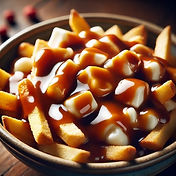Top Chef ™: Wisconsin
Season:
Week:
Supper Club

The chefs were invited to a supper club meal at the Harvey House, a restaurant in a former train-depot. They really enjoyed the food.
They were then split into two teams of five chefs and asked to prepare their own supper club menus for the judges and forty guest diners. Their menus were required to include a relish tray, fish dish, chicken dish, beef dish, and dessert. The guest diners included W. Kamau Bell, Tory Miler, pastry chef Kristine Miller, chef/co-owner Joe Papach, and creative director/co-owner Shaina Papach.

Get recipes ...
Subscribe to our weekly recipes and culinary tips from streamed cooking shows.
Dishes prepared in
Top Chef ™: Wisconsin
Kevin, presenting to the judges: "We have a beef tenderloin au jus. So it's like a cherry vinegar from Spain and little potatoes confit'd in butter and garlic and medium rare."
Danny's relish tray consisted of:
Pickled Vegetables
Black Garlic Tahini
Labneh with Za'atar
Smoked Whitefish
Frena Bread
Danny said, on presenting to the judges: "This is my version of a relish tray, kind of taking you to North Africa. I have a black tahini with black garlic, labneh with za'atar, pickles, smoked white fish, and then Frena bread."
Laura, presenting to the judges: "For dessert, you have a play on four leches. It's basically a tres leches cake but my inspiration came from the old fashioned brandy cocktail with brandy cherries, and I took that idea and added something boozy at the end of the meal, so there's a chocolate brandy mousse alongside the tres leches."
Rasika, presenting to the judges: "For your fish, I did my own take on fried fish and coated it in couscous and then shallow fried it. I also paired it with a peanut and jaggery, which is palm sugar dip, and a smoked sturgeon, mint dill, herby kind of sauce with that."
Manny, presenting to the judges: "I have a New York Strip loin, pistachio crusted, pommes purée with horseradish and cilantro and marcona almonds and salsa verde on top."
Charly said, when presenting to the judges: "What we have here is a play on something I grew up eating. We do a traditional epis rub, which is green spice with green onions and parsley. I also did a coconut epis sauce and a little relish we use in a cabbage and a little preserved lemon called pikliz."
Amanda, presenting to the judges: "This is my take on hot chicken. It's actually Katsu and Szechuan mala spice. The sauce is an apple miso mustard sauce, and the relish is just cabbage with a little sauerkraut. It's actually a katso sando."
Dan's relish tray consisted of:
Chicken Liver Mousse
Steak Tartare
Crudités in Soil
Dan, presenting to judges: "First off, I have a little bit of raw vegetables in soil. We have some steak tartare, with chicken liver mousse, pickled shallots, some dill stems, and a little bit of seed toast that's been lightly fried."
Michelle, presenting to the judges: "I made for you a coconut bread pudding with a pineapple cream sauce."
Savannah, presenting to the judges: "You have a chicken katsu. The sauce is an American white sturgeon caviar emulsion. And there's a little bit of a sweet pickled cabbage underneath of it."
Culinary Challenges inspired by
Top Chef ™: Wisconsin
Dawadawa is a traditional West African fermented seasoning made primarily from locust beans (Parkia biglobosa), though occasionally from soybeans or other legumes. The preparation begins by boiling the beans until soft, then pounding them to remove the seed coats. The cleaned seeds are boiled again, spread out, and covered with leaves to ferment naturally for 2-3 days. This fermentation process develops a pungent aroma and complex, umami-rich flavor profile. The resulting black paste is typically shaped into balls or patties for storage. Used as a flavor foundation in soups, stews, and sauces across Ghana, Nigeria, and other West African countries, dawadawa adds remarkable depth and nutritional value to countless dishes.
You can buy dawadawa spice here.
Pipian is a rich, traditional Mexican sauce that exemplifies the complexity of pre-Hispanic cuisine. Made from ground pumpkin or squash seeds (pepitas), this velvety sauce incorporates various chiles, spices, and sometimes nuts or seeds like sesame or peanuts. The ingredients are toasted, ground into a paste, and simmered with broth until thickened to a smooth consistency. Pipian can range from vibrant green (pipian verde) to deep red (pipian rojo), depending on the chiles used. Commonly served over poultry or pork, this sauce offers a nutty, earthy flavor profile with subtle heat that showcases Mexico's remarkable ability to balance complex flavors into harmonious dishes.
Tatemado is a traditional Mexican cooking technique most commonly associated with Jalisco cuisine. This slow-cooking method involves placing ingredients—typically meat such as pork, goat, or beef—into clay pots that are partially buried in hot coals or placed in an underground pit oven. The pots are sealed with masa (corn dough) to trap moisture and smoke, allowing the meat to cook gently for several hours until incredibly tender. This process imparts a distinctive earthy flavor while preserving the meat's natural juices.
Tatemado dishes are often seasoned with regional spices, chiles, and herbs, creating complex flavor profiles that showcase Mexico's rich culinary heritage. The result is meltingly tender meat with unparalleled depth of flavor.
Nage, pronounced "nahj," is a fragrant, aromatic broth used in French cuisine primarily for poaching seafood and vegetables. This delicate liquid is typically created by simmering wine, water, or fish stock with aromatic vegetables (onions, celery, fennel) and herbs. After cooking, the ingredients may be strained out, and the remaining liquid can be reduced and enriched with butter to create a "beurre monté" sauce.
The term 'nage' is also used to describe dishes cooked in this liquid—referred to as "à la nage"—resulting in light, flavorful preparations that highlight the natural taste of the main ingredient while infusing it with subtle complexity.
Poutine: Quebec's Beloved Comfort Food
Poutine is a Canadian culinary treasure originating from Quebec in the late 1950s. This hearty dish consists of three essential components: crispy french fries, cheese curds, and rich brown gravy poured generously over the top, creating a delicious mess of contrasting textures and flavors.
The magic of poutine lies in its seemingly simple yet perfectly balanced combination. When done right, the fries remain crisp on the outside while soaking up savory gravy. The cheese curds, which must be fresh to achieve their signature 'squeak' between your teeth, soften slightly from the heat without fully melting. The gravy ties everything together with its savory depth. It is basically a roux, traditionally thickened with chicken or beef stock but a vegetarian option is just as good, with flavor from umami-rich mushrooms or earthy beets.
To create authentic poutine at home, begin with freshly cut potatoes, twice-fried for optimal crispness - first at a lower temperature to cook through, then at a higher temperature for that golden exterior. The cheese curds should be room temperature and as fresh as possible. Their slightly tangy flavor and distinctive texture cannot be substituted with shredded cheese. For the gravy, create a flavorful stock reduction, thickened to a consistency that coats the back of a spoon without being gloopy.
Assembly requires careful timing. The fries must be piping hot from the fryer, immediately topped with curds and quickly covered with steaming gravy that's hot enough to warm the curds but not so hot it melts them completely.
While traditional poutine remains a beloved classic, modern variations might include toppings like pulled pork, smoked meat, or even lobster. Whether enjoyed from a roadside stand in rural Quebec or prepared in your kitchen, poutine represents comfort food at its finest. it is unpretentious, indulgent, and deeply satisfying.
Soba Cha (also known as Soba-Cha and Sobacha) is Japanese buckwheat tea. It is drunk hot or cold, and is gluten-free and caffeine-free and apparently tastes nutty and slightly sweet.
It appeared three times in Top Chef: Wisconsin ™. The first showing was in Restaurant Wars when Danny's team, under his leadership, served up cold Soba Cha as a welcome drink. It wasn't well received.
In reparation, Danny re-introduced it in week 12 when he infused mushrooms into Soba Cha for his fish dish. This time, the judges regretted that he had buried the flavor of the buckwheat tea in very powerful mushroom flavors and would have preferred the essence of the tea to shine through.
Danny didn't try again, but Dan used Soba Cha in his Smoked Dashi and this time it went down a storm.
Hummingbird cake is a Jamaican banana and pineapple spiced cake which has been eaten in the southern United States since the 1970s. It is a leavened cake with a salty cake and often contains pecans.
Mofongo is a Caribbean dish originating in Puerto Rico and the Dominican Republic. Made by mashing ripe plantains with fat, garlic, spices, and (optionally) pork crackling, it is then shaped into a ball. The dish is famous for its complex and contrasting textures, with fried plantains that are crispy on the outside and soft on the inside. It is often found topped with melted cheese and served with a clear garlic broth.
Danny, in the 'spoiler' for the Top Chef Wisconsin Finale, was heard to say that he wanted to get fresh scallops for his first course and treat them in the style of "Leche de Tigre".
Leche de tigre, (translates to tiger's milk), is the Peruvian term for a citrus marinade that cures fish or seafood. Also known as leche de pantera, this marinade usually contains lime juice, onion, chile, and fish sauce.
In the semi-finals of Top Chef Wisconsin ™ we saw Chef Danny out shopping in the Curacao markets and finding 'quenepas' which we heard he had eaten as a child.
Quenepa, also known as Spanish lime, mamoncillo, or limoncillo, is a tropical fruit native to the Caribbean, Central America, and parts of South America. It is a small, green fruit with a thin, leathery skin and a tart, juicy pulp surrounding a large seed. It isn't so tart that it is inedible and children often suck the juice and pulp, but it needs careful balancing in cooking.
Kewpie Mayonnaise is known for its richness, and has a tangy, savory "umami" character which sets it well above traditional store-bought. It is made using only the yolks of egg and typically uses rice wine vinegar. It has a rich creamy texture. We saw Chef Dan using it in his lionfish dish on the semi-final episode of Top Chef Wisconsin.
Frico is an Italian preparation which originates in times of hardship when cheese rinds could not be wasted. It is basically melted cheese which can be combined with seeds, spices, herbs, potato or grains and then cooked to any required degree of crispness.








































